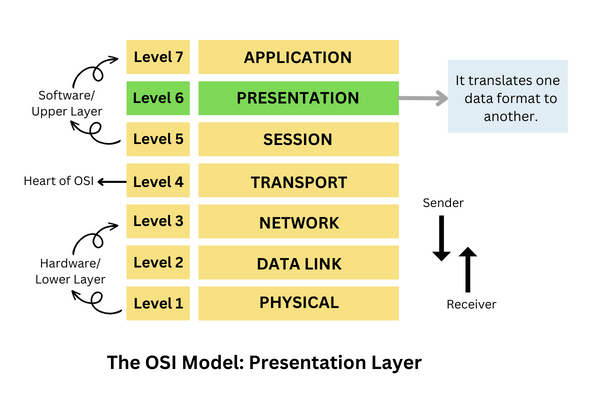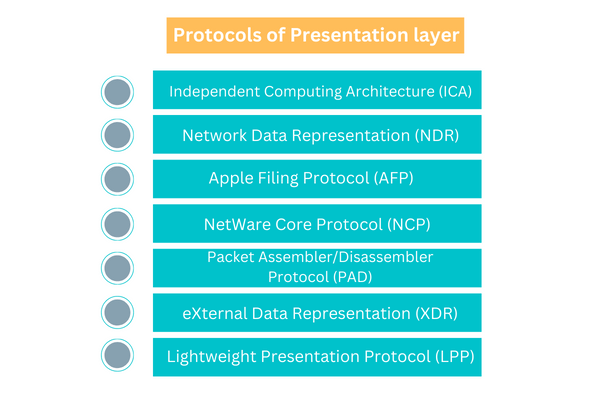Tutorial
Physical Layer
Data Link layer
Network Layer
Routing Algorithm
Transport Layer
Application Layer
Network Security
Misc
- Router
- OSI vs TCP/IP
- TCP vs UDP
- Transmission Control Protocol
- TCP port
- IPv4 vs IPv6
- ARP Packet Format
- ARP Table
- Working of ARP
- FTP Client
- FTP Commands
- FTP Server
- I2C Protocol
- Sliding Window Protocol
- SPI Protocol
- IP
- ARP Commands
- ARP
- Address Resolution Protocol
- ARP and its types
- TCP Retransmission
- CAN protocol
- HTTP Status Codes
- HTTP vs HTTPS
- RIP Protocol
- UDP Protocol
- ICMP Protocol
- MQTT protocol
- OSPF Protocol
- Stop and Wait Protocol
- IMAP Protocol
- POP Protocol
- CIFS
- DAS
- DIMM
- iSCSI
- NAS (Network Attached Storage)
- NFS
- NVMe
- SAN
- Border Gateway Protocol
- Go-Back-N ARQ
- RJ Cable
- Difference between Connection-Oriented and Connectionless Service
- CDMA vs. GSM
- What is MAC Address
- Modem vs. Router
- Switch Vs. Router
- USB 2.0 vs 3.0
- Difference between CSMA CA and CSMA CD
- Multiple access protocol- ALOHA, CSMA, CSMA/CA and CSMA/CD
- URI vs URL
- IMAP vs. POP3
- SSH Meaning| SSH Protocol
- UTP vs STP
- Status Code 400
- MIME Protocol
- IP address
- proxy server
- How to set up and use a proxy server
- network security
- WWW is based on which model
- Proxy Server List
- Fundamentals of Computer Networking
- IP Address Format and Table
- Bus topology and Ring topology
- Bus topology and Star topology
- Circuit Switching and Packet switching?
- Difference between star and ring topology
- Difference between Router and Bridge
- TCP Connection Termination
- Image Steganography
- Network Neutrality
- Onion Routing
- Adaptive security appliance (ASA) features
- Relabel-to-front Algorithm
- Types of Server Virtualization in Computer Network
- Access Lists (ACL)
- What is a proxy server and how does it work
- Digital Subscriber Line (DSL)
- Operating system based Virtualization
- Context based Access Control (CBAC)
- Cristian's Algorithm
- Service Set Identifier (SSID)
- Voice over Internet Protocol (VoIP)
- Challenge Response Authentication Mechanism (CRAM)
- Extended Access List
- Li-fi vs. Wi-fi
- Reflexive Access List
- Synchronous Optical Network (SONET)
- Wifi protected access (WPA)
- Wifi Protected Setup (WPS)
- Standard Access List
- Time Access List
- What is 3D Internet
- 4G Mobile Communication Technology
- Types of Wireless Transmission Media
- Best Computer Networking Courses
- Data Representation
- Network Criteria
- Classful vs Classless addressing
- Difference between BOOTP and RARP in Computer Networking
- What is AGP (Accelerated Graphics Port)
- Advantages and Disadvantages of Satellite Communication
- External IP Address
- Asynchronous Transfer Mode (ATM)
- Types of Authentication Protocols
- What is a CISCO Packet Tracer
- BOOTP work
- Subnetting in Computer Networks
- Mesh Topology Advantages and Disadvantages
- Ring Topology Advantages and Disadvantages
- Star Topology Advantages and Disadvantages
- Tree Topology Advantages and Disadvantages
- Zigbee Technology-The smart home protocol
- Network Layer in OSI Model
- Physical Layer in OSI Model
- Data Link Layer in OSI Model
- Internet explorer shortcut keys
- Network Layer Security | SSL Protocols
- Presentation Layer in OSI Model
- Session Layer in OSI Model
- SUBNET MASK
- Transport Layer Security | Secure Socket Layer (SSL) and SSL Architecture
- Functions, Advantages and Disadvantages of Network Layer
- Protocols in Noiseless and Noisy Channel
- Advantages and Disadvantages of Mesh Topology
- Cloud Networking - Managing and Optimizing Cloud-Based Networks
- Collision Domain and Broadcast Domain
- Count to Infinity Problem in Distance Vector Routing
- Difference Between Go-Back-N and Selective Repeat Protocol
- Difference between Stop and Wait, GoBackN, and Selective Repeat
- Network Function Virtualization (NFV): transforming Network Architecture with Virtualized Functions
- Network-Layer Security | IPSec Modes
- Next - Prev Network-Layer Security | IPSec Protocols and Services
- Ping vs Traceroute
- Software Defined Networking (SDN): Benefits and Challenges of Network Virtualization
- Software Defined Networking (SDN) vs. Network Function Virtualization (NFV)
- Virtual Circuits vs Datagram Networks
- BlueSmack Attack in Wireless Networks
- Bluesnarfing Attack in Wireless Networks
- Direct Sequence Spread Spectrum
- Warchalking in Wireless Networks
- WEP (Wired Equivalent Privacy)
- Wireless security encryption
- Wireless Security in an Enterprise
- Quantum Networking
- Network Automation
- Difference between MSS and MTU
- What is MTU
- Mesh Networks: A decentralized and Self-Organizing Approach to Networking
- What is Autonomous System
- What is MSS
- Cyber security & Software security
- Information security & Network security.
- Security Engineer & Security Architect
- Protection Methods for Network Security
- Trusted Systems in Network Security
- What are Authentication Tokens in Network security
- Cookies in Network Security
- Intruders in Network Security
- Network Security Toolkit (NST) in virtual box
- Pivoting-Moving Inside a Network
- Security Environment in Computer Networks
- Voice Biometric technique in Network Security
- Advantages and Disadvantages of Conventional Testing
- Difference between Kerberos and LDAP
- Cyber security and Information Security
- GraphQL Attacks and Security
- Application Layer in OSI Model
- Applications of Remote Sensing
- Seven Layers of IT Security
- What is Ad Hoc TCP
- What is Server Name Indication(SNI)
Presentation Layer in OSI Model
The presentation layer is the 6th layer from the bottom in the OSI model. This layer presents the incoming data from the application layer of the sender machine to the receiver machine. It converts one format of data to another format of data if both sender and receiver understand different formats; hence this layer is also called the translation layer. It deals with the semantics and syntax of the data, so this layer is also called the syntax layer. It uses operations such as data compression, data encryption & decryption, data conversion, etc.

Functions of the presentation layer:
- Translation:Data is sent from sender to receiver, but what if the sender device and receiver device understand different formats of code? For example, suppose one device understands ASCII code and another device understands EBCDIC code. In that case, the data must be translated into a code that the recipient understands to determine what data has been sent. The presentation layer is responsible for translating ASCII codes to EBCDIC or vice versa. With the help of the presentation layer, the receiver understands the data effectively and uses it efficiently.
- Encryption and Decryption: Whatever data is being transmitted between the sender and the receiver, that data must be secure because an intruder can hack the data passing between the sender and the receiver. Hackers can modify the data and send the modified data to the receiver to create false communication. The presentation layer is responsible for encrypting and decrypting data to avoid data leakage and data modification.
The plaintext data at the source is encrypted into ciphertext (unreadable format), then it is sent to the receiver, where the ciphertext is decrypted into plaintext. Now, if the hacker tries to hack the data, the hacker receives an encrypted, unreadable form, and if the hacker tries to send modified data, the receiver can detect the modification during decryption; thereby, the data remains safe. - Compression and Decompression: If the file size is large, it becomes difficult to transmit the large file over the network. File size can be decreased by compressing the file for easy transmission of data. Compression is the method of diminishing the size of a file to transmit data easily in less time. When the compressed data reaches the receiver, the data is reconstructed back to the original size, and this process is called decompression.
Sublayers of presentation layer in the OSI model:
The presentation layer in the OSI model is classified into two sublayers:
- Common Application Service Element (CASE): This sublayer offers services to layer-7, i.e., the application layer, and requests services from layer-5, i.e., the session layer. It supports various application services, such as Reliable Transfer Service Element (RTSE), Remote Operation Service Element (ROSE), Association Control Service Element (ACSE), and Commitment Concurrency and Recovery (CCR).
- Specific Application Service Element (SASE): This sublayer offers application-specific protocols, such as Message Oriented Text Interchange Standard (MOTIS), Remote Database Access (RDA), File Transfer Access and Manager (FTAM), Common Management Information Protocol (CMIP), Virtual Terminal (VT), Distributed Transaction Processing (DTP), Job Transfer and Manipulation (JTM), and others.
Protocols of the Presentation layer:

- Independent Computing Architecture (ICA): It is a presentation layer protocol in the OSI model, which was formed by Citrix Systems. It is used for transferring data from server to client. It is a very thin protocol as it does not require much overhead in order to transmit data from the server over to the client. It is well-optimized for the WAN.
- Network Data Representation (NDR): It is the protocol that is used to implement the presentation layer of the OSI model. It provides different kinds of data representation, such as images, video, audio, numbers, etc. It is used for Microsoft Remote Procedure Call (Microsoft RPC) and Distributed Computing Environment (DCE) / Remote Procedure Calls (RPC).
- Apple Filing Protocol (AFP): It is a communication protocol that was specifically designed for macOS by Apple, Inc. It provides file services for Classic Mac OS and macOS. This protocol is used to share files over the network.
- NetWare Core Protocol (NCP): It is a protocol that is associated with the client-server operating system. The user can access the directory, print, message, file, clock synchronization, etc., with the help of this protocol. It supports many platforms, such as Linux, Classic Mac OS, Windows NT, Mac OS X, and Microsoft Windows.
- Packet Assembler/Disassembler Protocol (PAD): It is a telecommunications equipment that splits a stream of data into separate packets and formats packet headers for asynchronous communication on X.25 networks. It receives packets from the network and converts them into a stream of data. The PAD provides many asynchronous terminal connectivities to a host computer.
- eXternal Data Representation (XDR): It is a computer network protocol that is used to transfer data between two systems. It was first published in 1987. XDR is used by various systems such as NDMP, Network File System, NetCDF, ZFS, Open Network Computer Remote Procedure Call, and others.
- Lightweight Presentation Protocol (LPP): It is a protocol that offers ISO presentation services over TCP/IP based networks. This protocol explains an approach to provide stream-line support for OSI over TCP/IP based networks.
Conclusion:
- In this article, you have studied the presentation layer in the OSI model. It is a 6th layer in the OSI model that translates one data format into another data format. The presentation layer may also be called the translation layer or syntax layer.
- You have learned about the functions of the presentation layer, such as translation, encryption & decryption, and compression & decompression.
- You have understood that there are two sublayers of the presentation layer, which are the Common Application Service Element (CASE) and the Specific Application Service Element (SASE).
- You have gained knowledge of several protocols of the presentation layer, such as Network Data Representation (NDR), Independent Computing Architecture (ICA), NetWare Core Protocol (NCP), Apple Filing Protocol (AFP), Packet Assembler/Disassembler Protocol (PAD), eXternal Data Representation (XDR), and Lightweight Presentation Protocol (LPP).


